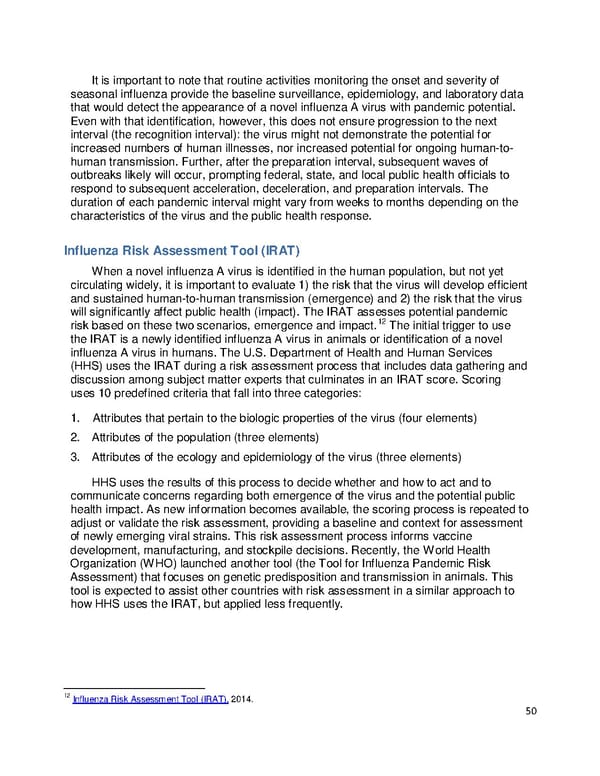It is important to note that routine activities monitoring the onset and severity of seasonal influenza provide the baseline surveillance, epidemiology, and laboratory data that would detect the appearance of a novel influenza A virus with pandemic potential. Even with that identification, however, this does not ensure progression to the next interval (the recognition interval): the virus might not demonstrate the potential for increased numbers of human illnesses, nor increased potential for ongoing human-to- human transmission. Further, after the preparation interval, subsequent waves of mpting federal, state, and local public health officials to outbreaks likely will occur, pro respond to subsequent acceleration, deceleration, and preparation intervals. The duration of each pandemic interval might vary from weeks to months depending on the characteristics of the virus and the public health response. Influenza Risk Assessment Tool (IRAT) When a novel influenza A virus is identified in the human population, but not yet circulating widely, it is important to evaluate 1) the risk that the virus will develop efficient and sustained human-to-human transmission (emergence) and 2) the risk that the virus will significantly affect public health (impact). The IRAT assesses potential pandemic risk based on these two scenarios, emergence and impact.12 The initial trigger to use the IRAT is a newly identified influenza A virus in animals or identification of a novel influenza A virus in humans. The U.S. Department of Health and Human Services (HHS) uses the IRAT during a risk assessment process that includes data gathering and discussion among subject matter experts that culminates in an IRAT score. Scoring uses 10 predefined criteria that fall into three categories: 1. Attributes that pertain to the biologic properties of the virus (four elements) 2. Attributes of the population (three elements) 3. Attributes of the ecology and epidemiology of the virus (three elements) HHS uses the results of this process to decide whether and how to act and to communicate concerns regarding both emergence of the virus and the potential public health impact. As new information becomes available, the scoring process is repeated to adjust or validate the risk assessment, providing a baseline and context for assessment of newly emerging viral strains. This risk assessment process informs vaccine development, manufacturing, and stockpile decisions. Recently, the World Health Organization (WHO) launched another tool (the Tool for Influenza Pandemic Risk Assessment) that focuses on genetic predisposition and transmission in animals. This tool is expected to assist other countries with risk assessment in a similar approach to how HHS uses the IRAT, but applied less frequently. 12 Influenza Risk Assessment Tool (IRAT), 2014. 50
 Pandemic Influenza Plan Page 49 Page 51
Pandemic Influenza Plan Page 49 Page 51